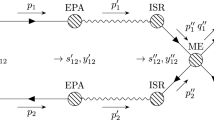Abstract
In physics simulation chains, the PHOTOS Monte Carlo program is often used to simulate QED effects in decays of intermediate particles and resonances.
The program is based on an exact multiphoton phase space. In general, the matrix element is obtained from iterations of a universal kernel and approximations are involved. To evaluate the program’s precision, it is necessary to formulate and implement within the generator the exact matrix element, which depends on the decay channel. Then, all terms necessary for non-leading logarithms are taken into account. In the present letter we focus on the decay K→πl ± ν l and tests of the PHOTOS Monte Carlo program. We conclude that there is a 0.2 % relative precision in the implementation of the hard photon matrix element into the emission kernel, including the case where approximations are used.








Similar content being viewed by others
Notes
Parametrization of phase space in PHOTOS is explicit and exact, if the presampler for collinear emissions is used only along a single charge. Otherwise, starting from the moment when the photon is supposed to be added to a more than two-body configuration, an approximation appears when the phase space Jacobians for the multitude of branches are combined. This can be improved, but for test cases with second order matrix elements in Z decay [9], we have found that this approximation is necessary, unless complete double photon emission amplitude would be installed into the program at the same time.
But then, no gain beyond Konoshita–Lee–Nauenberg can be achieved. In K e3 decay there is no Coulomb effect.
TAUOLA semileptonic decay channel offer an alternative crude phase space generator for radiative corrections, which may become useful in the future, especially if complete virtual corrections are to be included and studied.
The distributions of Lorentz invariants constructed from outgoing particles are shown. Additional information is available on plots of the web-page [23]. The SDP (shape difference parameter) obtained from MC-TESTER represents an exclusive surface (normalized to unity) under the green and red distributions. The statistical error (calculated in a rather simplified way) is subtracted from this difference. The black line is the ratio of the distributions.
References
M. Antonelli, V. Cirigliano, G. Isidori, F. Mescia, M. Moulson et al., Eur. Phys. J. C 69, 399 (2010)
S. Actis et al., Eur. Phys. J. C 66, 585 (2010)
D.R. Yennie, S. Frautschi, H. Suura, Ann. Phys. (NY) 13, 379 (1961)
S. Jadach, B.F.L. Ward, Phys. Rev. D 38, 2897 (1988)
S. Jadach, Z. Wa̧s, B.F.L. Ward, Comput. Phys. Commun. 130, 260 (2000). Up to date source available from http://home.cern.ch/jadach/
E. Barberio, B. van Eijk, Z. Wa̧s, Comput. Phys. Commun. 66, 115 (1991)
E. Barberio, Z. Wa̧s, Comput. Phys. Commun. 79, 291 (1994)
P. Golonka, Z. Was, Eur. Phys. J. C 45, 97 (2006)
P. Golonka, Z. Was, Eur. Phys. J. C 50, 53 (2007)
G. Nanava, Z. Was, Eur. Phys. J. C 51, 569 (2007)
G. Nanava, Q. Xu, Z. Was, Eur. Phys. J. C 70, 673 (2010)
N. Davidson, G. Nanava, T. Przedzinski, E. Richter-Was, Z. Was, Comput. Phys. Commun. 183, 821 (2012)
M.E. Peskin, D.V. Schroeder, An Introduction to Quantum Field Theory (Boulder, Westview, 1995)
S. Weinberg, Physica A 96, 327 (1979). Festschrift honoring Julian Schwinger on his 60th birthday
J. Gasser, H. Leutwyler, Ann. Phys. 158, 142 (1984)
H. Leutwyler, Ann. Phys. 235, 165 (1994)
V. Cirigliano, M. Giannotti, H. Neufeld, J. High Energy Phys. 0811, 006 (2008)
V. Cirigliano, in PoS (KAON), 007 (2008)
Y. Bystritskiy, S. Gevorkyan, E. Kuraev, Eur. Phys. J. C 64, 47 (2009)
M. Jeżabek, Z. Wa̧s, S. Jadach, J.H. Kühn, Comput. Phys. Commun. 70, 69 (1992)
P. Golonka, T. Pierzchala, Z. Was, Comput. Phys. Commun. 157, 39 (2004)
N. Davidson, P. Golonka, T. Przedzinski, Z. Was, Comput. Phys. Commun. 182, 779 (2011)
Projects 2011/12 on http://wasm.web.cern.ch/wasm/ or http://hibiscus.if.uj.edu.pl/~przedzinski/Kl3/
Particle Data Group Collaboration, K. Nakamura et al., J. Phys. G 37, 075021 (2010)
J.R. Batley et al. (NA48/2 Collaboration), Eur. Phys. J. C 50, 329 (2007). [Erratum-ibid. C 52, 1021 (2007)], hep-ex/0702015
N. Davidson, T. Przedzinski, Z. Was, PHOTOS interface in C++: technical and physics documentation. arXiv:1011.0937 [hep-ph]
Acknowledgements
We would like to thank Tomasz Przedzinski for help in obtaining the numerical results presented in this paper and Brigitte Bloch-Devaux for help in improving the paper readability. We would like to thank the referee of EPJC for identifying an error in our handling of formula (14) of Ref. [17].
Work of Q. Xu is supported by China–Poland inter-governmental cooperation grant 34-13, National Natural Science Foundation of China under Grant No. 11147023, and Zhejiang Provincial Natural Science Foundation of China under Grant No. LQ12A05003.
Work of ZW is supported in part by the Polish Ministry of Science and Higher Education grant No. 1289/B/H03/2009/37.
Author information
Authors and Affiliations
Corresponding author
Rights and permissions
About this article
Cite this article
Xu, Q., Was, Z. Bremsstrahlung simulation in K→πl ± ν l (γ) decays. Eur. Phys. J. C 72, 2158 (2012). https://doi.org/10.1140/epjc/s10052-012-2158-z
Received:
Revised:
Published:
DOI: https://doi.org/10.1140/epjc/s10052-012-2158-z





